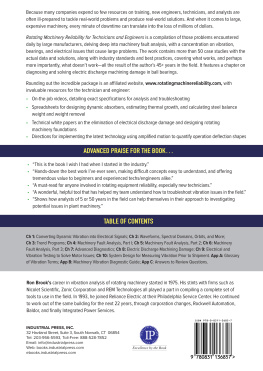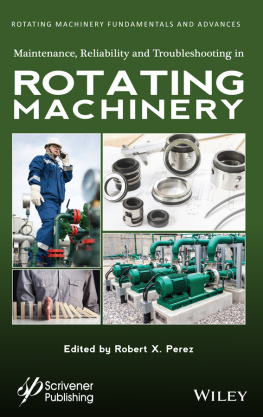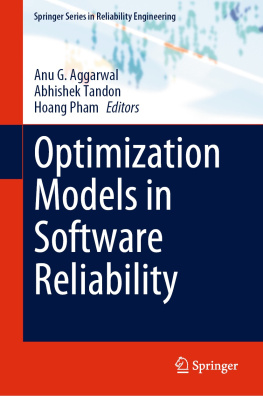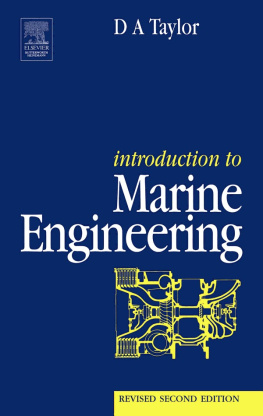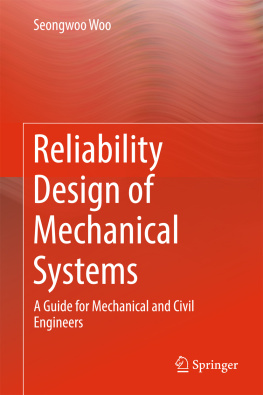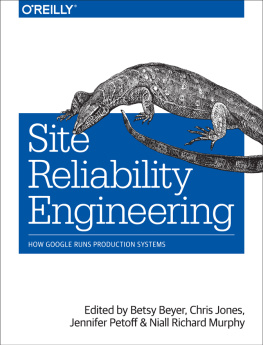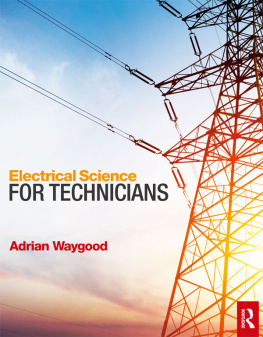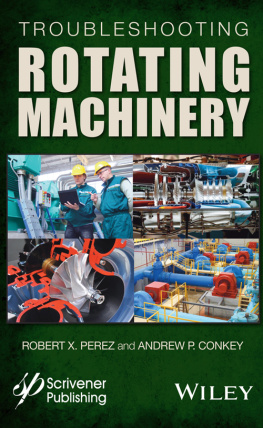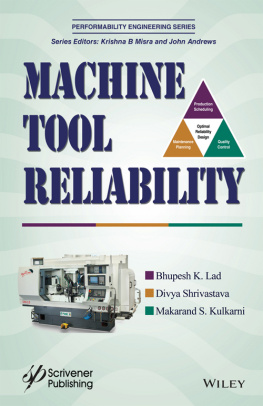W. Ron Brook - Rotating Machinery Reliability for Technicians and Engineers
Here you can read online W. Ron Brook - Rotating Machinery Reliability for Technicians and Engineers full text of the book (entire story) in english for free. Download pdf and epub, get meaning, cover and reviews about this ebook. year: 2022, publisher: Lightning Source Inc. (Tier 1), genre: Romance novel. Description of the work, (preface) as well as reviews are available. Best literature library LitArk.com created for fans of good reading and offers a wide selection of genres:
Romance novel
Science fiction
Adventure
Detective
Science
History
Home and family
Prose
Art
Politics
Computer
Non-fiction
Religion
Business
Children
Humor
Choose a favorite category and find really read worthwhile books. Enjoy immersion in the world of imagination, feel the emotions of the characters or learn something new for yourself, make an fascinating discovery.
- Book:Rotating Machinery Reliability for Technicians and Engineers
- Author:
- Publisher:Lightning Source Inc. (Tier 1)
- Genre:
- Year:2022
- Rating:4 / 5
- Favourites:Add to favourites
- Your mark:
- 80
- 1
- 2
- 3
- 4
- 5
Rotating Machinery Reliability for Technicians and Engineers: summary, description and annotation
We offer to read an annotation, description, summary or preface (depends on what the author of the book "Rotating Machinery Reliability for Technicians and Engineers" wrote himself). If you haven't found the necessary information about the book — write in the comments, we will try to find it.
W. Ron Brook: author's other books
Who wrote Rotating Machinery Reliability for Technicians and Engineers? Find out the surname, the name of the author of the book and a list of all author's works by series.
Rotating Machinery Reliability for Technicians and Engineers — read online for free the complete book (whole text) full work
Below is the text of the book, divided by pages. System saving the place of the last page read, allows you to conveniently read the book "Rotating Machinery Reliability for Technicians and Engineers" online for free, without having to search again every time where you left off. Put a bookmark, and you can go to the page where you finished reading at any time.
Font size:
Interval:
Bookmark:


This book is dedicated to all of the engineers and technicians that have shared the results of their hard work. Their experiences add to the body of knowledge utilized by todays field personnel to analyze, diagnose, and remedy problems with rotating machinery of all types.
Field technicians, OEM engineers, and end users can struggle to solve machinery problems. There arent many issues encountered that havent been identified and solved previously. That is the duty of every person involved in this field. Document your experiences so that future field test personnel dont have to reinvent the wheel.
Finally, to all managers of field service technicians: Give them time to learn.
The book has discussions on modal analysis and other technical items that are not possible to display in a book. The author has provided a website for the reader to download these articles, AVI files, and more at www.rotatingmachinereliability.com. They are indicated with one of these three icons:

I first met Ron Brook at Reliance Electric Corporation in 1993. We had a bearing EDM issue with a specific Hermetic motor application and needed some assistance in the field. Ron worked in the services division of Reliance Electric and was highly recommended by another engineer in our group, William Miller. Ron determined that circulating current in the shaft from common mode voltage stresses induced by the VFD was the root cause of our bearing fluting. We were unable to replicate this until the motor was operating in an oil and freon environment.
This was the start of a great friendship that spanned the next 27 years and continues today as Ron is an Engineer Emeritus in Fleet Engineering for Integrated Power Services providing consultative services to our Field Services Team. We never cease to be amazed by Ron. Typically, we reach out to him for assistance, and before we can finish explaining our findings, he has the next steps or a solution in mind.
Ron is a highly-regarded rotating equipment technologist who has tackled many of our industries most challenging application issues. Technical Associates of Charlotte classified Ron as a Category 5 Vibration Analyst, which includes more than 25 years of experience in the field, plus a working knowledge of rotor dynamics modeling, modal analysis, and finite element analysis. The Category 5 analysts must also have sufficient experience and subject matter knowledge so they can be called for expert testimony during litigation. Ron paved a path for us and left an indelible mark on our industry.
Rons book is the culmination of his 45 years of service to our industry. It provides invaluable insights to anyone who services and maintains rotating equipment. I would encourage all engineers and technicians who design, troubleshoot, or maintain rotating assets to read this book and absorb the concepts and diagnostic tools. It is a tremendous resource that provides a testament and legacy to the author.
Tom Reid
Senior VP Engineering and Nuclear Services
Integrated Power Services
Rotating Machinery
Reliability
for
Technicians and Engineers
W. Ron Brook
INDUSTRIAL PRESS, INC.
I have met thousands of people over my 45-year career. Some were excellent teachers; others were vendors whom I kept for my entire career just based on how they treated their customers. Ive been blessed with customers that were eager to learn about their machinery problems. Ive stood in front of a room full of people wanting to learn about the latest frequency analyzer and how it could benefit their company, worked with those who stayed and helped even though quitting time had come and gone, and managers who procured the equipment needed to perform the tasks at hand. The work is still interesting and that is why I still consult in retirement. This list of names will not include all those who helped and provided inspiration for this book, but Ive tried to spotlight the most influential of those folks. They comprise the following:
Roy Hench, who managed to get me through high school physics class; Robert Leon, who introduced his young field service crew to spectrum analyzers; Ralph Buscarello, my first formal vibration instructor; Charles Andrews, founder of DynaVibes Corporation; and Peter Phillips, the earliest coworker who tackled field problems.
Others include Patrick Link, the author of the first meaningful paper on identifying and solving electric discharge machining damage in bearings; Henry Bickel, Dick Rothchild, Reinhold Vogel, the brain trust of Nicolet Scientific, who believed a small crew of field-savvy technicians could add to the exposure of their product to field test engineers and technicians, when they purchased DynaVibes Corporation in 1980; George Fox Lang, Joe Deery, Randolph Perry, and Jack Heeg, who were all key to the success of the FFT; Dr. Donald Houser, of Ohio State University, who founded a museum dedicated to the FFT; Gerald Zobrist, President of Zonic Corporation, who believed a field technician could sell multi-channel signal processors and learn modal analysis; and Bill Owens, my first customer at Zonic Corporation.
Theres also Jim Lally, President of PCB Corporation, who only wanted to hear his customer say, I am a thoroughly satisfied customer (I was for more than 40 years); William H. Miller, inventor and engineer, who taught me rotor dynamics modeling; Welton (Doc) Blessing, my go-to answer man for anything involving motors or generators; Dr. William B. Fagerstrom, for his dedication to the reliability field; and Norm Stalker, for believing my results regarding any field warranty issue.
Id also like to thank Jim Berry, for his dedication to detail in describing vibration phenomena; James DAngelo, for always being available to answer my questions; Tom Flynn, for being the kind of manager any worker would appreciate; Scott Crickenberger and Tom Watson of Daiken/McQuay, for their 20 plus years of relying on me for the tough problems; and Peter Paranzino, for introducing me to LabVIEW. is dedicated to him.
To Tom Reid, without whose encouragement this book would still be in bits and pieces lying around my office and stuck in files inside old hard drives and servers. I will always proudly look back on his support with those difficult customers. It always helps to know that the VP of Engineering has your back.
The person who deserves the most credit, however, is my wife, Joan, for her patience and understanding through my last 15 years of work and the 5 long years it took to complete this book.
Acceleration. The time rate of change of velocity. Typical units are ft/s/s, meters/s/s, and gs (1g = 32.17 ft/s/s = 9.81 m/s/s). Acceleration measurements are usually made with accelerometers.
Accelerometer. Transducer whose output is directly proportional to acceleration. Most commonly use piezoelectric crystals to produce output.
Aliasing. A phenomenon which can occur whenever a signal is not sampled at greater than twice the maximum frequency component. Causes high frequency signals to appear at low frequencies. Aliasing is avoided by filtering out signals greater than the sample rate.
Alignment. A condition whereby the axes of machine components are either coincident, parallel or perpendicular, according to design requirements.
Amplification Factor (Synchronous).
Next pageFont size:
Interval:
Bookmark:
Similar books «Rotating Machinery Reliability for Technicians and Engineers»
Look at similar books to Rotating Machinery Reliability for Technicians and Engineers. We have selected literature similar in name and meaning in the hope of providing readers with more options to find new, interesting, not yet read works.
Discussion, reviews of the book Rotating Machinery Reliability for Technicians and Engineers and just readers' own opinions. Leave your comments, write what you think about the work, its meaning or the main characters. Specify what exactly you liked and what you didn't like, and why you think so.

